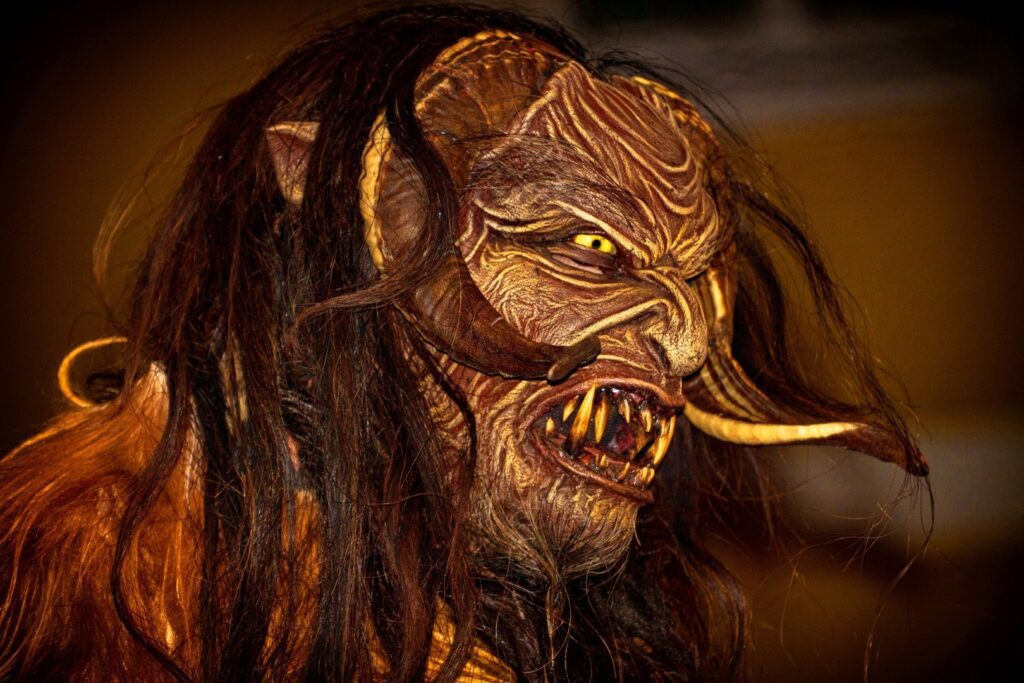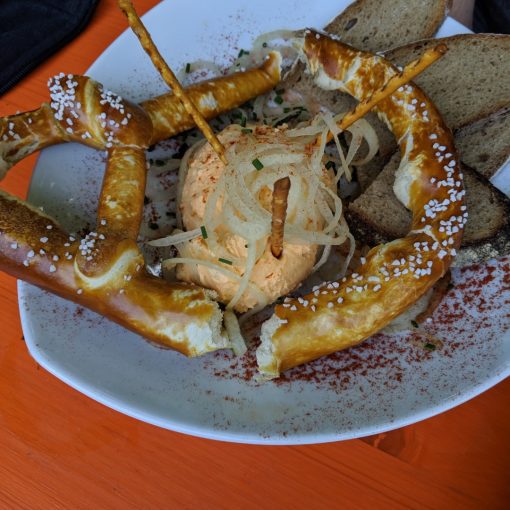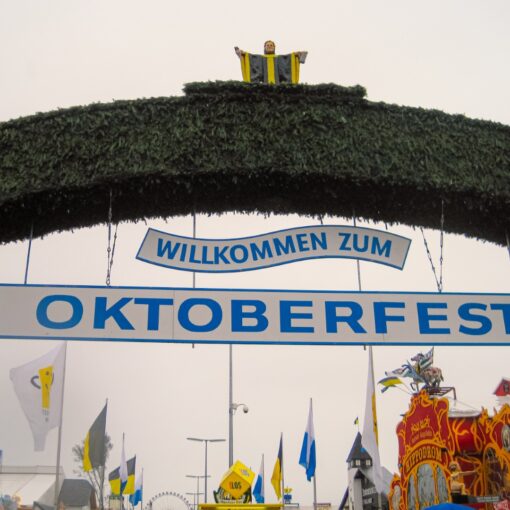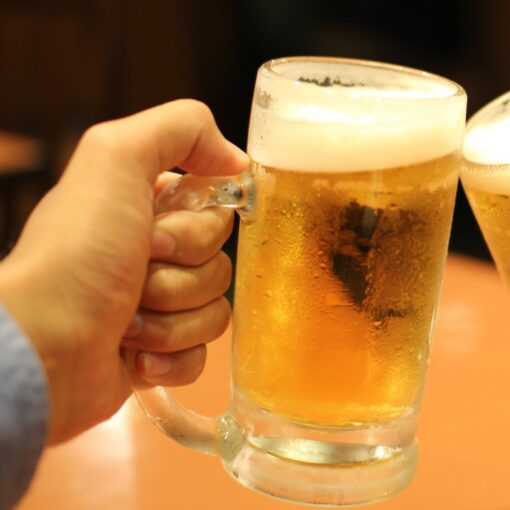“Silent night, holy night. All is calm….”
That is until the faint sound of bells begins to be heard on the 5th of December in the Alpine valleys of Germany. No, we aren’t talking about the beautiful sounds of church bells inviting villagers to come celebrate the wonders of Christmas.
Nope, everyone knows when they hear these bells, which will linger on into the late night, that it is something much more sinister. Something… devilish. The bells begin to echo in the whole valley off of the mountains and they begin to draw near. The hair on the back of your skin begins to stand as the anticipation grows…
Krampus.
Is.
Coming.
Limited Time- Free Krampus Tshirt Giveaway!
a Rafflecopter giveawayWhile I’ve lived in Germany now for the better part of a decade, I’ve found it really difficult to write a blog post about the Krampus German folklore story and events that unfold around the “German Beast Counterpart” to St. Nick- the absolutely terrifying Krampus.
I don’t struggle to write about this incredibly scary German Christmas tradition because I don’t know the story behind him or the Krampus mythology (I do.)
And I’ve actually been to my fair share of Krampus Runs in Germany so I even have first hand knowledge on what to expect at an authentic and local Krampuslauf.
No, I honestly struggle to write this story and information instead, because each time I sit down to write about Krampus, I struggle to put into writing exactly what emotions, ambiance, mood, and excitement go behind Krampusnacht in Germany.
In fact, because I’m just a mere Ausländer in Germany (AKA foreigner) and did not grow up with the reverence that many Bavarian children did for this devil-like creature, I have been fearful not only of Krampus himself but also that I simply can’t do the tradition justice. However, because it is such a special night in Germany and so many people continue to want to know more and more about Krampus, I’m going to do my best!!
Afterall, I am ALL about seeing Germany’s Iconic Sights balanced with the Authentic Delights! And you can’t get more German (well, Bavarian in this case) authentic than a half goat, half devil man who will steal children and take this to his lair!!!! (I mean, why??? Why does Germany have to go so hard!)
So, in this article, let’s cover it all. Is Krampus real?? Where can I watch Krampus? When is Krampus Day in Germany, and of course, Where is the best Krampus festival in Germany to attend (and what can you expect at a at Krampuslauf)!
TL;DR: Where to See A Krampus Fest in Germany
Munich Krampus Lauf: December 10,2023
Berchtesgaden: December 5, 2023
Pullman City: December 26th, 2023
Various Small Towns in the Oberpfalz Region of Bavaria: See Dates/Towns Here
Salzburg (Austria): Multiple Dates Listed Here
But First- Not Everywhere in Germany Celebrates Krampus
For some reason, the word, “celebrates” feels weird to describe a Krampusnacht festival in Germany. Maybe “observes Krampusnacht” may be more fitting?? Either way, here’s something you need to know about Germany:
Close your eyes and “picture” Germany. What do you see? Probably some fat bellied men in tight Lederhosen swinging a Maß of Bier around while signing “Ein Prosit.” Giant pretzels the size of your head. Alpine yodelers may even ring in your ears and fairytale castles nestled into the mountains feel like they’ve been plucked straight from a princess movie. And then there’s Krampus. Terryfying Krampus!
Yeah….all of those things? All stereotypes of Germany as a whole. Buuuuuut you want to know why I love living in Bavaria so much??? Those “stereotypes” are actually here!!!! When most people think of “Germany” they are actually thinking of “Bavaria.” (With a few exceptions, of course)
I say all this because if you are in other parts of Germany, they may not even know much about the Christmas Demon, let alone celebrate the “German” Krampus Christmas tradition!
But don’t worry, I’ve got the whole list of the best Krampus festivals and yes, even if you are going to be outside of Bavaria, you still might be able to find a terrifying fest to attend!
So, Who Is Krampus
Please note that some articles contain links that earn me a small commission at no extra cost to you.
If you don’t know the origin of Krampus yet, this half goat half devil is the counter part to the traditional St. Nicklaus in parts of Southern Bavaria. In Bavaria, they don’t do Santa Claus like we are used to in the US. There is a “Weihnachtsmann” who is the closest equivalence. However, at least in Bavaria, a beautiful angel (the Christkind-but more on her another time) is the one who comes to deliver all the presents and gifts on Christmas Eve.
But before then, on December 6th each year, St. Niklaus, (you know, THAT white bearded man) comes to the homes of the boys and girls and places fruits, treats, and goodies in their boots. He often makes his way from Kita (day cares) to Kindergartens showering the kids with little sweets and chocolates (and usually an orange or an apple!) At the Christmas Markets, you’ll almost always see a St. Niklaus and his beautiful friend, the Christkind.
And occasionally….on December 5th, before St. Nik has had a chance to reward the “good” boys and girls, in crashes Krampus!!! And what exactly does what does Krampus do to children?? Oh, you know….he snatches up any naughty kids and steals them away to his lair. That’s where he then EATS them, or “simply” just gives them a good beating with a hard, wooden rod!!!!!!
Yup. Germans take the whole “If you’re naughty, you’ll get a lump of coal” thing to a whooooole new level!
But he’s not the “Bad Santa in Germany-” this terrifying traditional goes back so much further than the Jolly ‘Ol St. Nicholaus
Looking for a better version of an “Ugly Christmas Sweater?” this year?
👇 Get one of these awesome Krampus shirts, scarfs, and other fun Krampus Gear!!👇

Is Krampus Real or Fake (and do Germans actually believe in Krampus?)
Oof. Try explaining this story to your 6 year old first grader who just learned about this.
To be honest, since I didn’t grow up in Bavaria, I always thought the legend of Krampus was “just a thing.” Like something kids had heard of, maybe even caught a glance of at a Christmas Market, but not like full on taught. You know, something equivalent to how Americans “know” about Big Foot…it’s like we “just do.”
So when my son came home from first grade last year in a full panic asking me things like, “Where does the krampus live?” or “Is Krampus still alive and if so, is he going to come get me in the middle of the night!?” I was like “Oh Oh. You need to calm down” (sorry, I’m currently in my “Am I a “Swiftie” era)
I calmly asked, “Oh, yes, the story of Krampus….Did one of the kids tell you about him?”
Wide eyed he said, “NO! We learned about it in Ethics Class!” (the equivalence to a “religion class”) I said, “Oh, a kid asked your teacher about it?” And he exclaimed, “NO! Frau H. had a whole lesson on it today!!”
What Does Krampus Look Like?
Depending on where in Germany or Austria you are (or what Krampus Festival you’re at), Krampus today may take a few different forms (this also depends on which Krampus you see…but more on the different “kinds” in a bit).
The most popular part of his look is the Krampus Mask, which traditionally is a hand carved, demonic looking face. Most will have horns and fangs. Some have unusually long, pointy noises and/or chins. Their bodies are typically covered in fur and their feet are hooves. Some will have chains while others have huge, giant bells. The ones that have chains are believed to be devilish like beasts, where the ones with ginormous bells actually are “Percthen” which often use their bells to drive away evil spirits.
In other areas, such as Bercthesgaden, instead of fur, the Krampus costume may be made of straw, but this is known more as the “Buttnmandl”
However, depictions in the 1800s almost always show Krampus as being a black, furry beast. The bottom half of his body is like a goat, with hooves and he is almost always seen shackled up in chains. He has long pointy ears and a rolling red tongue that can reach out and grab children. He is typically holding a pitchfork and birch branches for whipping.
The History of Krampus
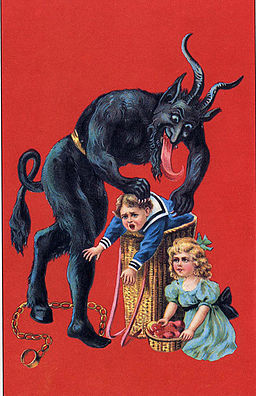
So where is Krampus from? Well, nobody is exactly sure, but most believe he originated in what is today’s Austro-Bavarian region (Salzburgerland) which includes Berchtesgaden (Germany), Salzburg, and St. Johann im Pongau (Austria) among other Alpine towns, however, he is especially popular in the South Tirol region of Austria as well.
While most sources say that Krampus originated from pagan traditions, some believe that’s not true at all. Instead, if you study Krampus, not much of this can be historically connected to specific pagan beliefs at all. Instead, he looks almost identical to the medieval depictions of what Catholics believe the Devil himself looked like- bound with chains, horned, long tongue, etc. And if you look at Catholic history, the real Saint Nicholaus (of Myra) is often credited with being an exorcist, so it would make sense that the two are a formidable pair.
So, while Germans often get a bad rep for being frightening, nobody does “scare the kids with nightmare stories” like Catholics (believe me, I was raised Catholic!) I guess put the two together and BAM! You’ve got yourself a Krampusnacth!!!!!
Krampus Today
Most “Stereotypes” about Germany (Lederhosen clad men, pretzels so big they cover your whole face, real life fairytale castles that inspired Disney himself) are actually not stereotypes. All those things exist! Well, at least in Bavaria. The reality is that when most people “Think of Germany” they often are envisioning Bavaria- why do you think I love living here so much!. (That’s not to say the rest of the country isn’t extremely worth your time, though!)
But it’s the same for Krampus traditions. Not only is Krampus in Bavaria predominantly, even more so, Krampus is most known in the Southern Alps of Germany and even more popular in Austria. In fact, the further North you get even in Bavaria, the more the legend changes and some GERMANS don’t even really know much about the so-called “Germany Christmas demon.”
Each region also may have its own take on Krampus (maybe a different name or even devlish entity, different times of the winter to celebrate it, etc) but traditionally speaking, Krampus still comes on December 5th to accompany St. Nicholaus.
On Krampusnacht (Again, Dec 5th and sometimes also on St Nicholaus Day- Dec 6th), St. Nick will wander the villages greeting the children, and right next to him, is mean ol’ Krampus.
Every town or village may have a different approach to this tradition. In the small village I first lived at in Bavaria, there was a local organization that would “terrorize” (in good jest) the Christmas Market crowd. At other markets, Krampus just kind of stomps around next to St. Nik.
And then there are some towns that go all out and put on some of the best Krampus festivals! At these, there is often a parade where spectators can watch, but in some places, it’s not just a spectator sport! Be prepared to be chased and even possibly get whipped!
Groups of Krampuses
(Krampi? What would be the plural form of Krampus!?)
For regions that revere this long standing tradition, boys as young as 16 can be initiated into their Krampus Group or Club (They often call it a “Pass” in Austria and a “Bass” in Germany) but once he’s married (at least in some locations) then he’s booted out!!
Other Names For Krampus
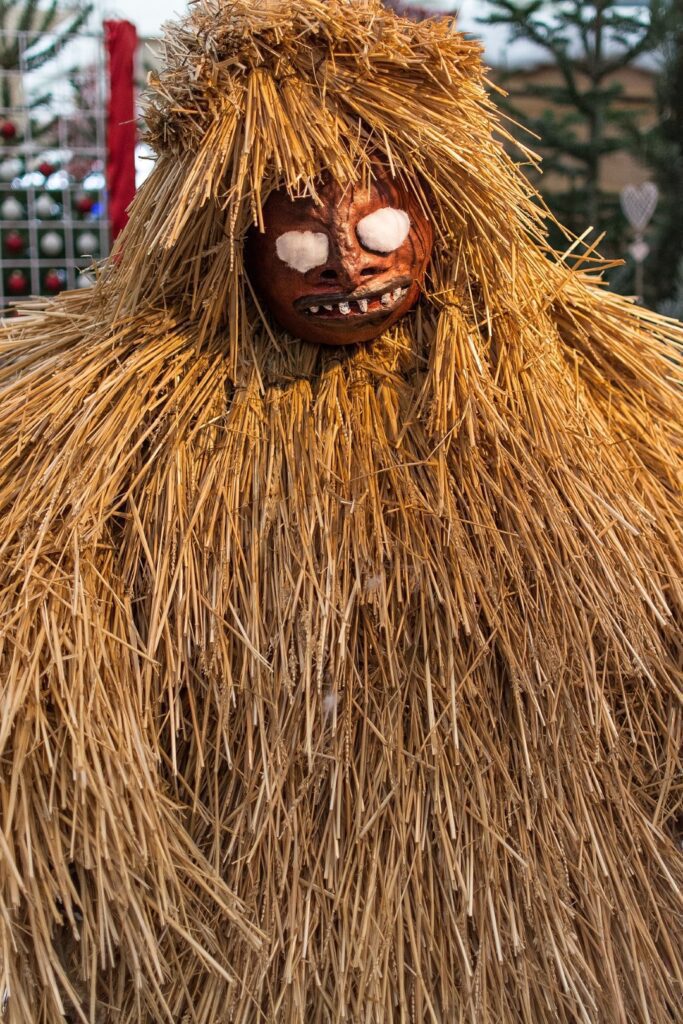
While the traditional Krampus (a half demon, half goat man) is probably the most well “known” of the German Christmas Demons, you can find even more authentic, cultural experiences in the heart of Bavaria. Depending on the region you are in, or even what tradition the locals are practicing, you may see several different names. Most are different dialects for Krampus, but some are even variations of the similar “theme” of the story of Krampus.
Krumpus: Just a dialact variation
Kramperl: This is an even more “Bayerisch” (Bavarian) term for Krampus
Knecht Ruprecht: Knecht Ruprecht and Krampus are actually not the same, but the idea of scaring little children into behaving is similar enough and they are both “celebrated” on St. Nicholas Day.
Just like Krampus, Knecht Ruprecht tags along with St. Nick but instead of being Devil-like, he’s just a bit more on the mischievous side. Instead of terrifying wooden masks, Knecht Ruprecht is typically seen wearing a long robe with a pointed hat. He is more commonly found in areas around Franconia (Northern Bavaria), especially at places like the Nuremberg Christmas Market, which is often considered one of the Best Christmas Markets in Germany.
Belsnickl: Very similar to Krampus, Belsnickl (or Belsnickel) is more common in the Saarland region of Germany (the area that borders France)
Teufel: The word “Teufel” literally translates to “Devil!” Many different Pass or Bass groups will call themselves Tuefels (usually in conjunction with their town’s name)
Buttnmandl: Most common in the Berchtesgadenerland and come with a “Bass” (or group). However, in this region, you’ll almost always find at least 3 Buttmandl together along with 1 St. Nick and very often an Angel.
Percthen: Perchten also aren’t actually Krampus, but many times these creatures get easily confused with Krampus. I’ll talk more about Percthen below but there are two kinds of Pertcthen
- Schönperchten (good Perchten- they bring good luck and chase out evil spirits)
- Schiachperchten (“bad” Percthen- similar to Krampus)
*Percthen actually don’t traditionally come on December 5th or 6th, but instead during the “Rauchtnacht” which is a period between Christmas and the Epiphany (January 6th)- but let’s cover that more in a bit, because there are also Perchtenlaufen! (Runs/Parades)
What Does A Truly Traditional Visit by Krampus Look Like? (By the locals)
Like I said above, many towns will have a Krampus “wreak chaos” at a Christmas market or even have their own Krampus lauf.
But there is a small region in Germany with truly one of the most traditional, cultural experiences I’ve ever seen. One of the most popular areas for the German Krampus is in the Bercthesgadenerland (South East corner of Germany, bordering Austria, near Salzburg). It’s something one can truly only understand by experiencing it themselves. It’s an amazing insight to a foreign culture with strange customs and traditions.
Here, the tradition goes back to the 16th century, and even today, the charade of how the Krampus visits still lives on in the villages with the locals and families. While the legend of Krampus sounds terrifying to most people, for anyone who grew up with this event in the Berchtesgaden, it’s actually somehow an incredibly special, magical night. There’s an electric feeling in the air as the entire village prepares for the coming of the Krampus. A mixture of giddy excitement and nervous chills fills the atmosphere every 5th of December.
The Kramperl Gather
First, the Kramperl (or in Berchtesgaden, they are often referred to as Buttnmandl) gather atop of the mountain to survey the valleys and land below. It is an ominous site knowing that in just moments, these beasts will descend onto the village!
But first, the group (Bass) will gather to say prayers, such as the Our Father, Ave Maria, and the Angel of the Lord. Traditionally, a farmer’s wife would bless them with holy water as St. Nicklaus and and Angel preside over the gathhering.
As the darkness begins to fall over the land, children and families begin to hear the clamoring of cowbells from far above on the mountain side. Krampus is near!
The Streets are Filled With Wildings!
Slowly, the large group of Krampus and Buttnmandl, wrangled by St. Nick and the Angel decent upon the town. It’s a sight unlike any other as they stampede the cobblestone streets of the Altstadt.
Children and families begin to run inside their homes and wait……
A traditional Berchtesgaden Bass will include at least 3 Krampus alongside St. Nicklaus, who is sure to keep those wildings in order.! There is often an Angel (sometimes the Christkind) that accompanies the Bass as well.
The Buttnmandl Go Home to Home
Next, the Bass goes from house to house. Yes. The demons come into the individual family rooms with children waiting nervously for them!
However, you can’t have a wild Buttmandl running amock inside your home! So, when they arrive, it’s customary for the homeowner (and/or St. Nick) to shower the Buttnmandl with holy water to help tame them and then St. Nick DEMANDS the beast to rest!! They may sing a few songs or say some prayers next for good measure to really make sure the Buttmandl behave.
St. Nicklaus Rewards the “Good Kids” On His List
Then, St. Nick pulls out his list of good deeds that the individual children have done. Yes, he really does have a book ready and prepared to read aloud what good deeds Sally has performed this year!! He’ll call on the kids one by one and read aloud from his book things that he “saw” them do that were kind or “good” behaviors that year. The kids also may sing a few songs or say some prayers next to really make sure they are on St. Nick and the Christkind’s good side.
The Buttnmandl Find the Naughty Kids
Traditionally, St. Nick would then hand out goodies of fruit and nuts and maybe some chocolate. For fun, the Buttnmandl will often find a “naughty” person in the family to “throw out in the snow” such as a giggling teenager or willing father. The whole Bass then moves onto the next house to do the whole performance again. It can take all evening and even throughout the following day (Dec 6th) to get through all the houses in the villages.
Oh, and for you women reading this, if you get whipped by Krampus, watch out, as it’s said that you’ll be extra fertile!
Tip: In many places (basically anywhere where you see the word “Run”) the spectacle of Krampus has taken on a whole touristic vibe. If you want to experience the true Krampus (the beast that is merely a subdued sidekick of St. Nick) then it’s best to find a smaller, local village to experience an authentic Krampusnacht, such as in Berchtesgaden
What To Expect At a Krampus Festival
What is the “Best Krampus Festival?” Well, are you looking for a local (more traditional) event or are you looking for a big ol’ scary Krampus Parade and event?? Depending on what you go to will greatly impact the kind of experience you have.
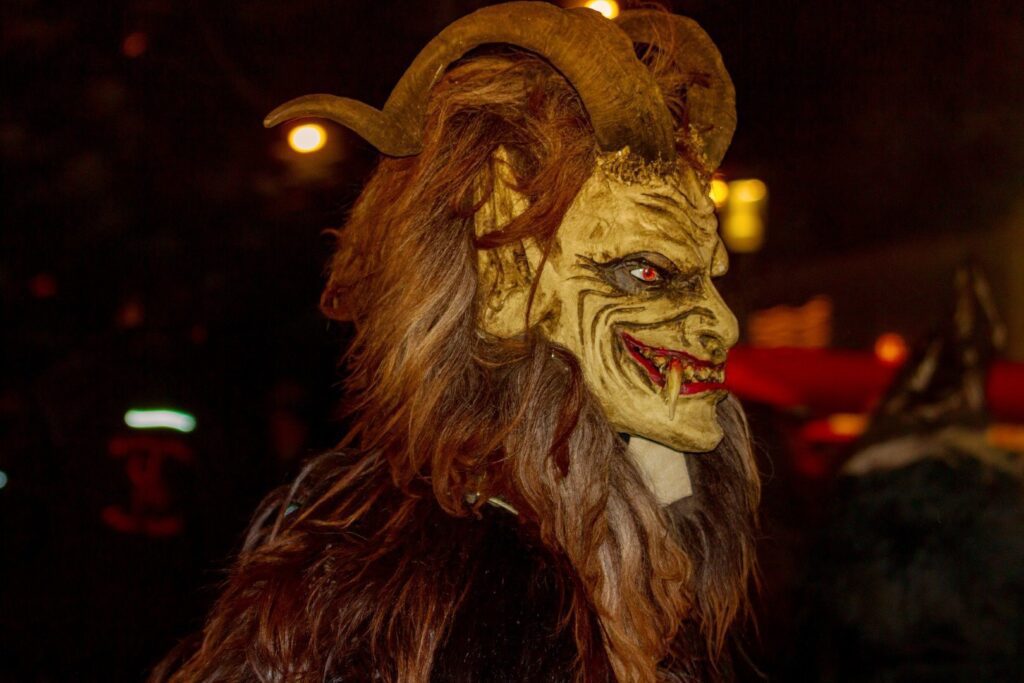
Local Events Large Krampus Celebrations (Krampuslauf)
While the big Krampuslauf is an experience for sure, the “Krampus Parades” in Germany have been a bit sensationalized and are often purposely theatrical and extravagant.
However, find a small village in Bavaria for Krampusnacht 2023 and it will still be a pretty authentic experience. The local groups typically come in the evenings, often after dark (which doesn’t say much since it is already dark by 4:30 pm in Germany in the winter!) They typically find a teenager who looks like an easy target or an unassuming adult to “Chase” or jump at. It’s more of a spectacle to watch as opposed to them truly “out to get you.”
However, if you are going to a bigger German Krampus festival, such as the Munich Krampus run, then you need to know that the true tradition of him side by side with St. Nick has been replaced with a mentality of “shock and awe” for spectators. The following statements are true for the big parades and festivals (not so much at the traditional, local events)
Large Krampus Celebrations (Krampuslauf)
This is NOT a Spectator’s Sport: Go at your own risk!
This isn’t a “Set you folding chair up next to the street and wave to all the Krampus strolling on down the street” kind of parade! This is a “Be apart of the adventure” kind of thing!
No, seriously, at some of the bigger events, like the Berlin Krampus Parade and the Munich Krampus Run, people legit come back saying they got whipped….as in “Let me show you this MARK I have on my leg!” OUCH!!!! No, it’s not just for show at some of these parades.
Crowds
At the bigger parades and events, there can be massive amounts of people and crowds. You’ll want to show up at least an hour or so early, as crowds will form and if you are left in the back, you may not have good vantage points.
Booze
You thought Oktoberfest was Germany’s main drinking event? (Ok, it pretty much is, but Wait, Hold my Beer!) In a traditional Pass, it’s said that some schnapps may help to appease the beasts. So, as a bystander, you are sometimes encouraged to hand out Schnapps to make sure the demons behave themselves. Unfortunately, this has kind of taken on its own issue in and of itself, as some Krampus have a bad reputation for maybe having a few too many schnapps.
Cold
Sure, the booze and Gluhweins might help, but since it’s not like the Christmas markets where you are walking around, you may find yourself pretty cold just standing there waiting for the parade to start! Make sure you’ve read my Packing For December In Germany article so you know what clothes to wear to stay toasty!
Where to See Krampus in Germany
Germans have a lot of stereotypes. Just like how Oktoberfest is not synonymous with all of Germany (as neither is Lederhosen), Krampus is not celebrated everywhere in Deutschland. In fact, you’ll probably only find Krampus in Southern parts of Bavaria, particularly in the Alps. The furthest “North” I’ve seen him is in the Oberpfalz region of Bavaria.
In fact, the whole “Krampusnacht” thing has started to cause a bit of controversy amongst local Germans. Not because of how insane the concept of a demon stealing children is (nah, that’s cool, right?) but instead because they are afraid that their long standing, deeply cultural tradition is going to become too commercialized and crazy.
Because of this, outside of the big, major (cough cough pretty touristy, which is still fine bc it’s quite an experience still) Krampus Laufens, it’s actually often pretty difficult to get exact locations of where a Krampusnacht might be. Many smaller villages want to keep this a local tradition and are quite protective of the very special evening that they have grown up with.
Luckily for you, I live in a region that loves celebrating this folklore, so I know where quite a few are! However, I beg that if you do go to a more “local” Krampusnacht that you are still respectful of any local traditions. I don’t want to be known as “That blogger that ruined Krampusnacht for everyone” mmmmmkay?
The two main “places” you can expect a Krampus appearance are at:
Weihnacthsmarkts
At Christmas Markets throughout Germany, on the 5th of December, St. Nikolaus goes out to greet the children. But, in parts of Bavaria, St. Nicholas and Krampus come together. For example, one year when I was at the beautiful Dinkelsbuhel Christmas Market (as part of my 10 Days in Bavaria Christmas Market Itinerary) and St. Nick was basically dragging a Krampus around who was in chains (he must have been particularly mischievous that day).
Unfortunately, these aren’t always widely advertised since it is still a very local tradition and often it is just a local group that just shows up, so it is hard to plan for tourists. I have a few listed below though that I have either personally been to myself or that I see in my local events.
Krampus will also often show up at the markets on December 6th as well since that is St. Nicholas’ Day.
At a Krampuslauf
Something that is becoming popular, especially in parts of Austria, where they are trying to monetize the ever growing popularity of Krampus is to have a designated Krampus Parade (Krampuslauf literally means “Krampus Run”)
These Krampus festivals are intense and one of a kind! Some of the most popular are the Munich Krampus Run and the Krampus Salzburg Krampuslauf. Huge groups of Kramperl terrorize the streets. They run after spectators, grab people to “take them to their lair”, and even whip people on the legs with their birch sticks!!!
No. I’m not joking. This. Is. Real!
Of course, it’s all done in “good fun” but ask anyone who has gotten the birch rod on their calf and they may tell a different tale of “fun”!
It’s also said that Krampus may behave a little more if you offer plenty of schnapps to him (it doesn’t hurt to have some yourself).
In some places, people like to take the association of the Devil to the after-party. And what better heathen music than Black Metal! Some places have even had Heavy Metal bands and parties at nearby pubs to keep the party going.
Krampusnacht with Kids?
If you are traveling in Germany with kids, be careful. I have three (young) kids myself and I would be paying dearly for months to come if we were around when some Krampus came around at a Christmas Market!!! I was shocked that they were full-on teaching the kids lessons about Krampus in school (those were some fun nights reassuring my son that he was not going to be stolen away in the middle of the night!!!) If we would have ran into some in person, no doubt all three of my kiddos would be sleeping in bed with me for the foreseeable future!
Granted, the Krampus don’t normally come until dark, but in Germany in the Winter, that can be as early as 4:30pm. So, if you’ve got younger kiddos, as much fun as Krampusnacht is for adults, I highly recommend heading in early on those nights if you don’t want your kids to be scarred for life.
Or….do as the Germans do, I suppose! I bet your kids will be pretty well-behaved for a while after that! After all, I guess that IS the whole point of Krampus in Germany!!!
I will say though, when a Krampus arrives, it’s usually no secret. You’ll hear the chains and bells and people hooping and hollering. If that’s the case and you’ve got skittish kiddos, just quickly head to a different area of the market.
Krampuslaufs and Krampus Festivals in Germany
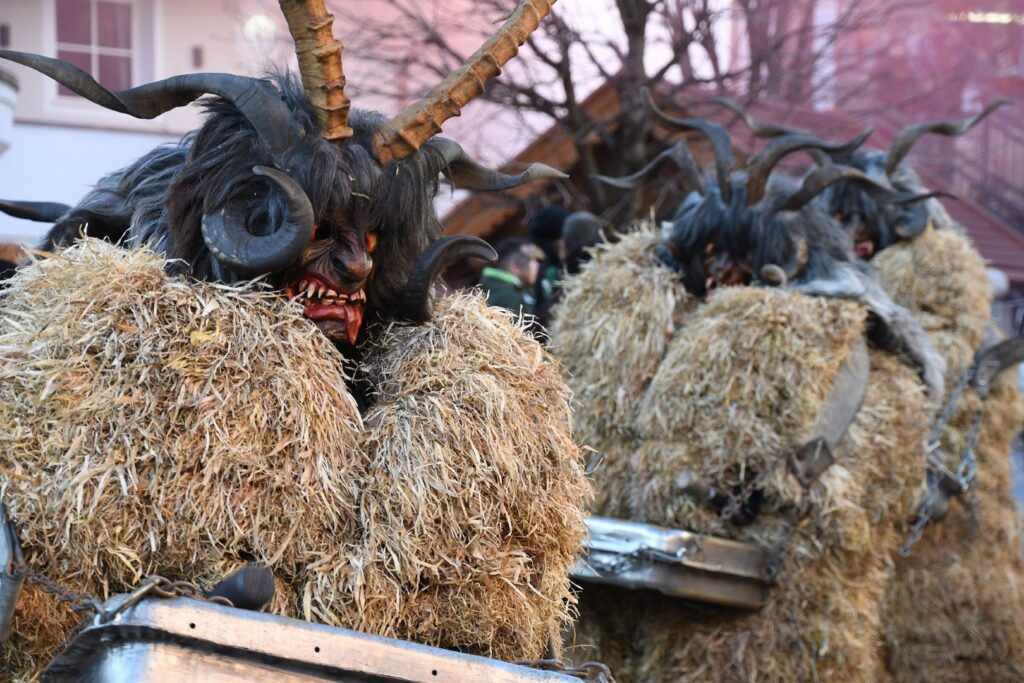
Note: Berchtesgaden is both the name of the general region as well as a specific town IN the Berchtesgaden region.
Berchtesgaden (town) is probably the most traditional place for a German Krampus Night. The Bass (group) often starts high above the valley, so that the sinister sounds of the bells drawing nearer and nearer builds the anticipation.
Sometimes in town, the Bass may be “released” from a cave (or sometimes a barn, depending on where in town you are) and then the Kramperl with giant bells on their backs begin to parade down the main street. Bunttlmandl will accompany them as well.
As noted above, the Bass go from home to home visiting families and children, often in the afternoon and early evenings, leaving plenty of time for another good romp in the streets after dark.
Dates: Every year on December 5th and 6th, in the Berchtesgaden valley basin and main streets of town
Munich Krampus Run 2023
The “Krampuslauf über den Münchner Christkindlmarkt” might just be the most popular of all the Krampus festivals in Germany. Every year, over 400 Kampus and Perchten alike run through the streets of the Munich Christmas Markets creating quite a scene!
Due to its accessibility and popularity, it’s no surprise that the Munich Krampus Parade can get packed and crowded. If you want a front row seat to see the Krampus, be sure to arrive at the streets at least an hour before the event starts (or more).
Dates: December 10th, 2023 Starting at 3pm
In the past, there has also sometimes been a second Munich Kramps Run a few days after Christmas, I’ll update the article if that is announced.
Oberammergau Krampus Run
While not as touristy and popular as the Munich Krampus Run or the traditional Bercthesgaden night, Obberarmergau usually has its own little Krampus parade where St. Nick can be watched heading down the main street in a horse drawn carriage, led by no other than his Kramperl.
If you want something a bit less chaotic than Munich but still an authentic experience, this is a great option.
Dates: Every year on December 5th
Oberpfalz Region
The Oberpfalz region of Bavaria is a small section just East of Nuremberg and stretches to the Czech Border. Regensburg and Neumarkt are two towns that fall within this area, but there are plenty of small towns and villages as well.
There is a very special group called the Oberpfälzer Schlossteufeln that go around to local towns for Krampus Parades and festivals and to the local Christmas Markets.
I particularly like these events because they are:
- Often at smaller Christmas Markets (this is actually one of my favorite Tips For Visiting Christmas Markets because the smaller markets often are more local, authentic feeling and typically have more handmade items than the huge markets)
- This Group is Great With Kids. When I have seen this group at the smaller markets (I particularly saw them in the small village of Parsberg) instead of chasing kids, they are more playful with them- handing out high fives, tossing hair, even giving hugs! But that doesn’t mean they won’t give the teens and adults a good jolt!
You can find their scheduled either on their regularly updated Facebook page or their website
Dates: Will Vary. Check the links for all locations and dates
Oberpfälzer Schlossteufeln: Calendar of events
Join their Facebook Page for frequent updates as well
Pullman City
Pullman City (Theme Park) is actually pretty well known for its Christmas Market. So, with so many tourists, it’s no surprise that they have their own Berchta Bass as well. They have a full on “Rought Night” (Rauhnacht) shebang with tons of Krampus and Berchta! Since Berchta is more of a “casting out” tradition and more typically done before the new year, Pullman City’s Krampusnacht is typically right after Christmas each year.
Date: December, 26, 2023. Festivities start in the afternoon. Parade begins at 6pm
Frau Perchta- The Female Krampus?
Frau Perchta is NOT the feminine version of Krampus. She is her own terrifying legend in and of itself. There are numerous stories, legends, and myths to exactly who Perchta is though. In some places, she goes by Berchta, or Bertha, and in others is simply known as “Spinnstubenfrau” (Spinning Room Lady).
But who is Frau Perctha? Is she a Goddess? A “Christmas Witch?” A murderous old hag?
No matter who she is, one thing is very, very clear. She must be German through and through! How do I know this? Because if there is one thing she hates, it is a messy house!! (Yup- Like I said….she MUST be German!) So, if she arrives at your home before the Epiphany (January 6) and your home is not tidied, then be prepared for her wrath, which could include anything from setting your “unwoven fibers” ablaze in your spinning room (because, you know…who doesn’t have a spinning room still- and no, I don’t mean a Pelaton!). But fires may be the least of your concerns if she finds you have an unorganized home. She may sneak into your room as you lie sleeping dreaming of all your Christmas goodies, gut your stomach out and replace it with none other than rocks!!!
Want to get on Perchta’s good side? Besides keeping that home nice and clean, just simply leave her a bowl of porridge!
Percthenlaufs
A Percthen run is similar to a Krampus run and sometimes they are even combined.
There are many Perchtenlauf in Germany where Percthen (the “associates” of Frau Perchta) are not devils but rather lost souls. They are not there to so much scare little children into being nice, but instead, their job is to chase away evil winter spirits. Therefore, these masked individuals look a bit less “Devil” like and more “Monsterous” In fact, they are often believed to bring good luck!
While you may see Perctha at a Krampus Run, she actually often has her own designated Perchtenlauf, which is traditionally around the last three Thursdays before Christmas. In many places instead of Krampusnacht, these evenings are “Berchtlnacht”
What To Expect At a Krampus Festival

If you are not going to the smaller villages, but rather a bigger festival, such as a Krampus Run, then know that the true tradition of him side by side with St. Nick has been replaced with a mentality of “shock and awe” for spectators. The following statements are true for the big parades and festivals (not so much at the traditional, local events)
- This Is Not A Spectator’s Sport: If you are not going to the smaller villages, but rather a bigger festival, such as a Krampus Run, then know that the true tradition of Krampus and St. Nick, side by side has been replaced with a mentality of “shock and awe” for spectators. You very well may get chased and even “whipped” with a birch rod
- Crowds: Again, at the big events, you’ll want to show up at least an hour or so early, as crowds will form and if you are left in the back, you may not have good vantage points.
- Booze: In a traditional Pass, it’s said that some schnapps may help to appease the beasts. Unfortunately, this has kind of taken on its own issue in and of itself, as some Krampus have a bad reputation for maybe having a few too many schnapps after all.
- Cold: Sure, the booze and Gluhweins might help, but since it’s not like the markets where you are walking around, you may find yourself pretty cold just standing there waiting for the parade to start! Make sure you’ve read my Packing For December In Germany article so you know what clothes to wear to stay toasty!
Where to See Krampus in Germany
Germans have a lot of stereotypes. Just like how Oktoberfest is not synonymous with all of Germany (as neither is Lederhosen), Krampus is not celebrated everywhere in Deutschland. In fact, you’ll probably only find Krampus in Southern parts of Bavaria, particularly in the Alps. The furthest “North” I’ve seen him is in the Oberpfalz region.
Many locals who see Krampusnacht not as a tourist attraction, but as a long standing, deeply cultural event in their region are afraid that Krampus is becoming too commercialized. Therefore, it’s often difficult to get exact locations of where a Krampusnacht might be. Many smaller villages want to keep this a local tradition and are quite protective of the very special evening that they have grown up with.
Weihnacthsmarkts
At Christmas Markets throughout Germany, on the 5th of December, St. Nikolaus goes out to greet the children. But, in parts of Bavaria, St. Nicholas and Krampus come together.
Unfortunately, these aren’t always widely advertised since it is still a very local tradition and often it is just a local group that shows up, so it is hard to plan for tourists.
Krampus also often will show up at the markets on December 6th as well.
Note: If you are traveling in Germany with kids, be careful. Granted, they normally don’t come until dark, but in Germany in the Winter, that can be as early as 4:30. If you’ve got younger kiddos, as much fun as Krampusnacht is for adults, I highly recommend heading in early on those nights if you don’t want your kids to be scarred for life. Or….do as the Germans do, I suppose! After all, I guess that IS the whole point of Krampus in Germany!!!
Krampuslauf
Something that is becoming popular, especially in parts of Austria, where they are trying to monetize the ever growing popularity of Krampus is to have a designated Krampus Parade (Krampuslauf literally means “Krampus Run”)
These Krampus festivals are intense and one of a kind! Some of the most popular are the Munich Krampus Run and the Krampus Salzburg Krampuslauf. Huge groups of Kramperl terrorize the streets. They run after spectators, grab people to take them to their lair, and even whip people on the legs with their birch sticks.
No. I’m not joking. This. Is. Real!
Of course, it’s all done in “good fun” but ask anyone who has gotten the birch rod on their calf and they may tell a different tale of “fun”!
It’s also said that Krampus may behave a little more if you offer plenty of schnapps to him (it doesn’t hurt to have some yourself).
In some places, people like to take the association of the Devil to the after-party. And what better heathen music than Black Metal!
Krampuslaufs and Krampus Festivals in Germany

Bercthesgaden
Berchtesgaden (town) is probably the most traditional place for a Germany Krampus Night. The Bass (group) often start high above the valley, so that the sinister sounds of the bells drawing nearer and nearer builds the anticipation.
Sometimes in town, the Bass may be “released” from a cave (or sometimes a barn, depending on where in town you are) and then the Kramperl with giant bells on their backs begin to parade down the main street. Bunttlmandl will accompany them as well.
As noted above, the Bass go from home to home visiting families and children, often in the afternoon and early evenings, leaving plenty of time for another good romp in the streets after dark.
Dates: Every year on December 5th and 6th, in the Berchtesgaden valley basin and main streets of town
Munich Krampus Run
The “Krampuslauf über den Münchner Christkindlmarkt” might just be the most popular of all the Krampus festivals in Germany. Every year, over 400 Kampus and Perchten alike run through the streets of the Munich Christmas Markets creating quite a scene!
Due to its accessibility and popularity, it’s no surprise that this Krampus Parade can get packed and crowded. If you want a front row seat to see the Krampus, be sure to arrive at the streets at least an hour before the event starts.
There are often two main dates for the run. One around St. Nicholas day and the other a few days before Christmas.
Dates: Last year, it was on December 11, 2022. I will update for 2023 as soon as the dates are released
Oberammergau
While not as touristy and popular as the Munich Krampus Run or the traditional Bercthesgaden night, Obberarmergau usually has its own little Krampus parade where St. Nick can be watched heading down the main street in a horse drawn carriage, led by no other than his Kramperl.
Dates: Every year on December 5th
Oberpfalz Region
The Oberpfalz region of Bavaria is a small section just East of Nuremberg and stretches to the Czech Border. Regensburg and Neumarkt are two towns that fall within this area, but there are plenty of small towns and villages as well.
There is a very special group called the Oberpfälzer Schlossteufeln that go around to local towns for Krampus Parades and festivals and to the local Christmas Markets.
I particularly like these events because they are:
- Often at smaller Christmas Markets (this is actually one of my favorite Tips For Visiting Christmas Markets because the smaller markets often are more local, authentic feeling and typically have more hand made items than the huge markets)
- This Group is Great With Kids. When I have seen this group at the smaller markets (I particularly saw them in the small village of Parsberg) instead of chasing kids, they are more playful with them- handing out high fives, tossing hair, even giving hugs! But that doesn’t mean they won’t give the teens and adults a good jolt!
You can find their scheduled either on their regularly updated Facebook page or their website
Dates: Will Vary. Check the links for all locations and dates
Pullman City
Pullman City (Theme Park) is actually pretty well known for its Christmas Market. So, with so many tourists, it’s no surprise that they have their own Berchta Bass as well.
Date: Last year, it was on December 26th. I’ll update if the date changes for 2023
Perchtenlaufs in Germany
Since Percthen are more associated with the Rauchtnacht, which is the period between Christmas and the Epiphany, the Perchtenlaufs don’t always happen on December 5th (the eve of St. Nicholas Day) but instead are often anytime during advent.
Kirschseeon Perchtenlauf
While many Perchten and Krampuslaufs coincide now, this traditional Percthenlauf is more about banishing the demons of the winter. The Percthen light fires, dance, and go door to door (often making quite the ruckus) making sure that only happiness and fertility remain in the land.
Advent begins on December 3, 2023. Epiphany ends on Jan 6, 2024. Check the calendar for exact dates of the events
Address: Fritz-Litzlfelder-Str. 14, 85614 Kirchseeon
Bad Tölz
While it’s called the “Romantic” Bad Tölz Christmas Market, I’d say there is quite a different ambiance than “Romantic” when the Perchten arrive! You can expect over 60 “Wildlings” at this event.
Date: Last year, the event was on December 27th, 2022. I will update as soon as I see the 2023 dates
Krampus and Percthen Local Groups
There are also tons of local groups that go to nearby towns and villages. In fact, they are almost countless and near impossible to all list here. However, if you can find a local chapter of a group then you are bound to find their schedule of events.
Near Passau: Passauer Burgdeiffen and Dreiflüsseteufel Passau
Laabertal: Hoellenteufel
Burghausen: Wöhrsee Teufel
Where to See Krampus in Austria
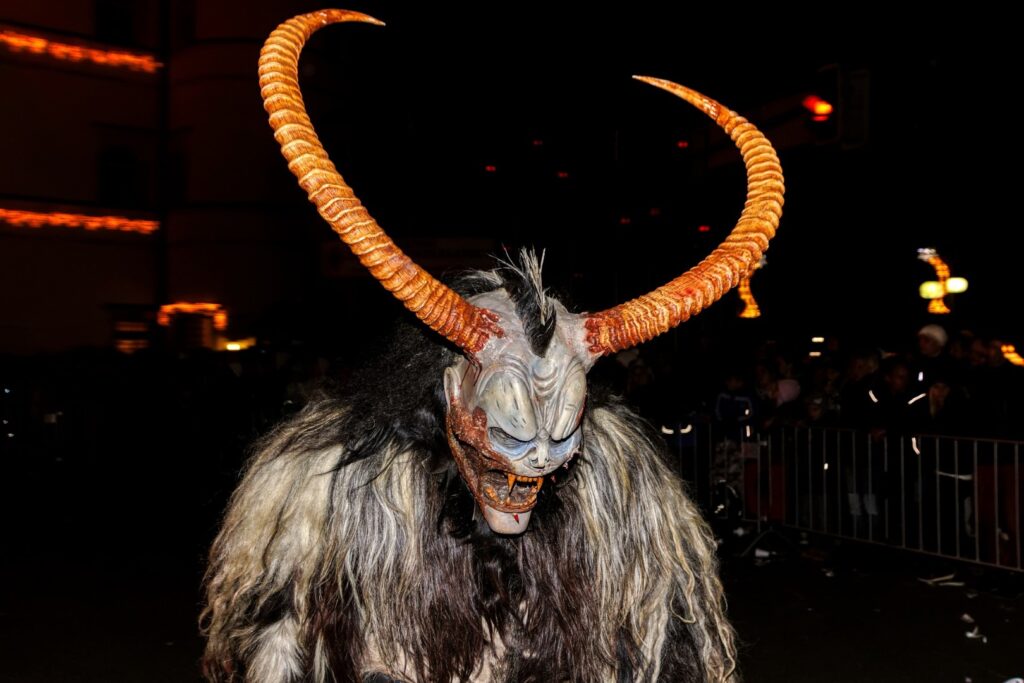
While most people automatically think of the German Krampus, Austria actually has FAR more events, parades, and runs! In fact, while Krampus is only known in just the small corner of Bavaria, you are sure to find Krampus in all nooks and crannies of Austria! Here are just a few of the more famous ones (closest to Germany)
Salzburgerland
There are tons of Krampus Festivals and Percthen events in the Salzburgerland region of Austria which is just over the border of the German Bavarian border.
Krampus Salzburg Run
The Salzburger Krampuslauf is one of the most popular in the area, with supposedly upwards of 1000 Percthen and Krampus free to roam! In the town’s Christmas Market, around 6:30pm, the streets become chaos and wild with Krampus after Krampus, many chasing spectators around….all in good fun, of course!
But one of the reasons why this is so popular is because the Krampus don’t JUST come to the Christmas market, they can be found all over town.
There are runs all throughout December, so be sure you get to one to have quite the experience!
Dates: There are tons of Krampus Runs in Salzburg starting November 26th and going through December 8th. Check This Website For Different Events/Dates
Johann im Pongau
This is another fantastic Krampusrun, again, with over 1000 Krampus. Set in the mountains, Johann im Pongau is a beautiful place to be any time of year, but it’s especially great during Krampusnacht, with one of the most famous ones in Austria.
The Krampus parade takes yearly on December 6th in the upper part of the village.
Date: December 5th and 6th at 7:30pm (the main street will be closed starting at 4:30pm)
There is also ypically Kids Krampus run at 7pm
Bad Goisern
Another fantastic event to take note of is the Bad Goisern Krampus Parade! Even though this one is very large, they still try to keep the tradition that Krampus is the counter-part to St. Nicholas. Therefore, the whole festive experience starts around 5pm when St. Nick shows up with all sorts of little goodie bags for little kids, especially children who can recite a prayer or poem for him. The Krampus parade continues, with each “Pass” being announced.
Date: December 7th 2023
Marktplatz, 4822 Bad Goisern
Kids Krampus Run
In the town of Thumersbach, near Zell am See, there is a special kind of Krampus Run….a Kinder Krampus Parade! Little kids, instead of adults, don the masks and outfits and march down the street themselves!
Date: Annually on December 3rd at 6.00 p.m
5700 Thumersbach, Dorfplatz
Krampus Südtirol
Toblach in Alta Pusteria
While this one is a bit further from Germany, actually much closer to Italy, it is said that the Toblach Krampus Südtirol event is the oldest in the Südtirol region.
Do you have any Krampus festivals you’d like me to add to the list? Let me know in our Travel in Bavaria Facebook Group or shoot me an email!

